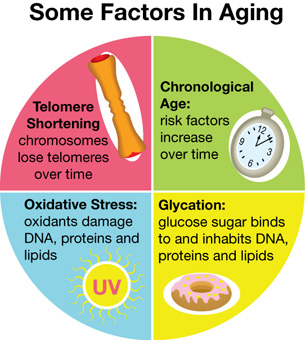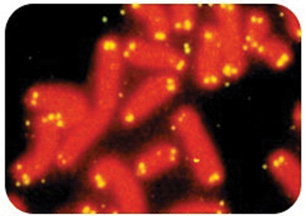Module 5
1. Module 5
1.14. Page 3
Module 5—Cell Division: The Processes of Mitosis and Meiosis

© 2008 The University of Utah, Genetic Science Learning Center
 Reflect and Connect
Reflect and Connect
By creating copies of DNA in S phase, and then carefully separating those identical sets of DNA into new cells during mitosis, cells ensure that the next generation has all the information it needs to continue life. Each new cell has the same number of chromosomes as its parent cell. Through this process, succeeding generations are provided a similar set of characteristics.
However, bodies do change over time. For example, human skin is not as elastic in old age as it is in youth. What could be causing this? The source of aging seems to be twofold. One factor is built into the process of copying of DNA, while the other is linked to environmental stress.

U.S. Dept of Energy, Human Genome Program
In addition to environmental stress, DNA faces challenges from within. Each time DNA is copied in S phase, it is not perfectly copied. Instead, the ends of chromosomes, known as telomeres, are shortened just a bit. Telomeres protect the chromosome in much the same fashion as a plastic tip protects a shoelace. When these ends are too short, the chromosomes can no longer be copied and they do not function properly; as a result, the cell and its line die. Cells can divide 50 times at best, no more.
telomere: a section on each end of a chromosome that shortens with each mitotic division
If the telomere is too short, the cell no longer divides.
The environment in which you live is harsh. There are all kinds of chemicals and radiation that can break up human DNA or cause changes known as mutations. An example of these chemicals is known as oxidants. These are highly reactive substances containing oxygen, which are always present but that increase with infection and with consumption of alcohol, cigarettes, and highly processed foods. Another concern is high levels of glucose, which can bind to DNA and cause it to stop functioning. Mutation, oxidants, and high glucose can all cause cells to die. Even if the cells escape death, the cell line may be forever reduced in function or become a cancerous growth.
Read more about cancer and the application of the principles of mitosis on pages 560 to 561 of your textbook.
 Discuss
Discuss
A lot of attention has recently been given to telomeres and their role in the aging process. Cancer cells seem to pay attention to them too, as most cancers turn on a gene to create telomerase, an enzyme that will prevent the shortening of telomeres. However, telomeres are not the single factor in aging. Excess sugar, alcohol, smoke, and processed foods full of chemicals seem to cause far greater damage to DNA and can shorten your lifespan. Research and its funding are limited. Should the focus be to find gene treatments to lengthen telomeres, or should focus be given to programs that encourage people to reduce behaviours that put their health and longevity at risk?
Take a position on this issue and communicate it to your classmates and your teacher in the course discussion area.
 Try This
Try This
TR 2. What three functions does mitosis serve in your body?
TR 3. In which phase of mitosis does each of the following events occur?
- migration of sister chromatids to opposite poles
- condensation of chromatin into compact chromosomes
- formation of a nuclear membrane
- alignment of chromosomes along the cell equator
TR 4. Sketch the four phases of mitosis. Include labels to explain what is happening in each phase.
TR 5. What role does the spindle apparatus play in cell division?
TR 6. Briefly explain the link between cell cycle regulation and cancer.
TR 7. The scientists in a lab have isolated a substance that prevents cells from synthesizing microtubules. What impact would this substance have on cell division? Explain.
TR 8. A scientist studying a group of somatic cells notices that upon the completion of the cell cycle, half of the daughter cells have no chromosomes and the other half have 92 chromosomes. In what phase of mitosis did an error likely occur? Explain your reasoning.
Discuss your answers with your teacher and save them to your course folder for later review.
 Reflect on the Big Picture
Reflect on the Big Picture
Throughout their life cycle, human bodies require continual renewal. Due to environmental stress and injury, cells die and must be replaced. Mitosis provides very quick and effective cell division. Starting with just one cell, mitotic division will quickly cover damaged or infected tissue with healthy new cells. These new cells will all function like their parent cell, will have the same number of chromosomes, and will be nearly genetically identical. All members of your family will not undergo mitotic division at the same rate or with the same effectiveness. A sister or brother just entering a growth spurt will have dramatic rates of mitosis. Grandparents or great-grandparents will have many cell lines that can no longer effectively reproduce new cells. The shorter cell cycle as cells age eventually puts a limit on the body’s life cycle.
 Going Beyond
Going Beyond
Pop a pill or change your lifestyle.
In this lesson you were introduced to two factors that cause aging. One is built into cells, but the other is environmental. Environmental factors have been linked to “risky” behaviours, like overeating, consuming alcohol, or smoking. A lot of research goes into creating medications or treatments that combat the effects of these behaviours.
Using the Internet, your local library, or other community resources you might have access to, conduct your own research to find out about new treatments or medications that are being introduced to the market to combat the negative effects of certain lifestyle choices. Organize your findings into a presentation style of your choice, and share it with your classmates in the course discussion area.
 Module 5: Lesson 3 Assignment
Module 5: Lesson 3 Assignment
Submit your completed Module 5: Lesson 3 Assignment to your teacher for assessment.